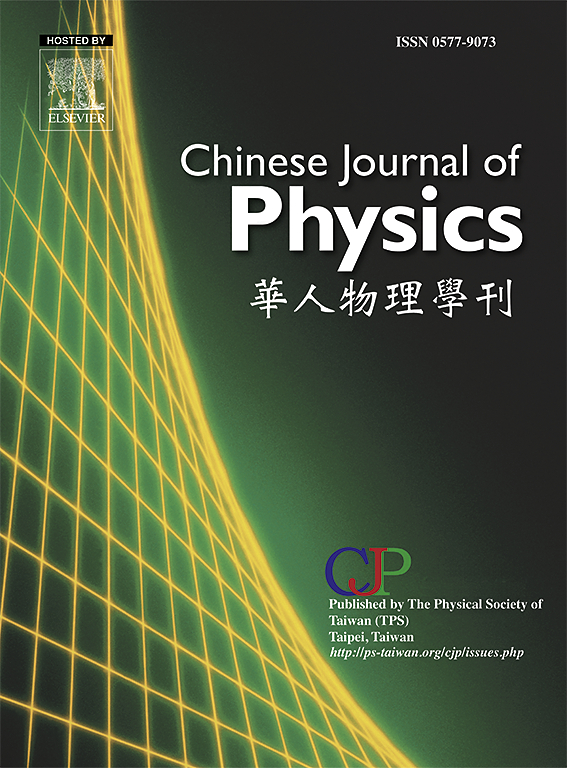Fabrication and application of periodic silver hollow nanorod arrays for enhanced photoluminescence
IF 4.6
2区 物理与天体物理
Q1 PHYSICS, MULTIDISCIPLINARY
引用次数: 0
Abstract
This study examines the optical properties of a periodic silver hollow nanorod array (PSHNA) substrate with varying nanorod heights fabricated using a nanosphere lithography method. Finite element method (FEM) simulations were performed to analyze the absorption spectrum and electric field distribution of the PSHNA substrate. The results revealed localized surface plasmon resonance peaks at approximately 560, 580, and 595 nm for nanorod heights of 250, 350, and 450 nm, respectively. The electric field was found to be strongly localized around the nanorods, confirming the unique properties and enhanced photonic behavior of the PSHNA substrate. By adjusting the etching time of inductively coupled plasma reactive-ion etching, the nanorod heights were controlled at 250 ± 5, 350 ± 9, and 450 ± 13 nm to match the simulation conditions of the FEM. Experimental absorption spectra showed a distinct absorption peak near 595 nm for the PSHNA substrate with a nanorod height of 450 ± 13 nm. Photoluminescence (PL) intensity of the 4-(dicyanomethylene)-2-t-butyl-6-(1,1,7,7-tetramethyljulolidyl-9-enyl)-4H-pyran (DCJTB) molecules demonstrated a significant enhancement of 14.68-fold for this particular nanorod height. Additionally, time-resolved PL measurements indicated the shortest PL decay time for the PSHNA substrate with a nanorod height of 450 ± 13 nm, coinciding with the PL band for DCJTB. These findings provide valuable insights for designing and optimizing optical devices based on PSHNA structures.

用于增强光致发光的周期性银空心纳米棒阵列的制备与应用
本研究考察了采用纳米球光刻方法制备的具有不同纳米棒高度的周期性银空心纳米棒阵列(PSHNA)衬底的光学性质。采用有限元模拟方法分析了PSHNA衬底的吸收光谱和电场分布。结果表明,当纳米棒高度为250、350和450 nm时,局部表面等离子体共振峰分别约为560、580和595 nm。发现电场在纳米棒周围强烈定位,证实了PSHNA衬底的独特性质和增强的光子行为。通过调整电感耦合等离子体反应离子刻蚀时间,将纳米棒高度控制在250±5、350±9和450±13 nm,以满足有限元模拟条件。实验吸收光谱显示,纳米棒高度为450±13 nm的PSHNA衬底在595 nm附近有明显的吸收峰。4-(二氰乙烯)-2-t-丁基-6-(1,1,7,7-四甲基julolidyl-9-烯基)- 4h -吡喃(DCJTB)分子的光致发光强度在特定纳米棒高度下显着提高了14.68倍。此外,时间分辨PL测量表明,PSHNA衬底的PL衰减时间最短,纳米棒高度为450±13 nm,与DCJTB的PL波段一致。这些发现为基于PSHNA结构的光学器件的设计和优化提供了有价值的见解。
本文章由计算机程序翻译,如有差异,请以英文原文为准。
求助全文
约1分钟内获得全文
求助全文
来源期刊

Chinese Journal of Physics
物理-物理:综合
CiteScore
8.50
自引率
10.00%
发文量
361
审稿时长
44 days
期刊介绍:
The Chinese Journal of Physics publishes important advances in various branches in physics, including statistical and biophysical physics, condensed matter physics, atomic/molecular physics, optics, particle physics and nuclear physics.
The editors welcome manuscripts on:
-General Physics: Statistical and Quantum Mechanics, etc.-
Gravitation and Astrophysics-
Elementary Particles and Fields-
Nuclear Physics-
Atomic, Molecular, and Optical Physics-
Quantum Information and Quantum Computation-
Fluid Dynamics, Nonlinear Dynamics, Chaos, and Complex Networks-
Plasma and Beam Physics-
Condensed Matter: Structure, etc.-
Condensed Matter: Electronic Properties, etc.-
Polymer, Soft Matter, Biological, and Interdisciplinary Physics.
CJP publishes regular research papers, feature articles and review papers.
 求助内容:
求助内容: 应助结果提醒方式:
应助结果提醒方式:


